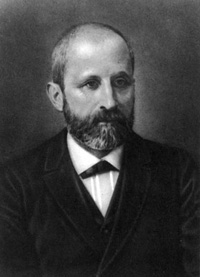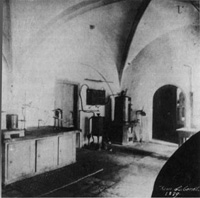Discovering DNA Teach article
Dean Madden from the National Centre for Biotechnology Education at the University of Reading, UK, describes how DNA was discovered - and how it can be simply extracted in the classroom.

In 1868, Johann Friedrich Miescher travelled from his native Switzerland to Tübingen in Germany. The 24-year-old had come to study in the laboratory of Ernst Felix Hoppe-Seyler, a pioneering biochemist who coined the modern name for the red pigment in blood: haemoglobin. After several months of toil in a laboratory in the cellar of Tübingen Castle, Miescher managed to isolate a previously unknown acidic substance from white blood cells (leucocytes) which had been washed from pus-laden bandages from a nearby hospital. Miescher called his discovery ‘nuclein’ because it was found in the nuclei of the cells. This substance was impure, however, and Hoppe-Seyler insisted on repeating the work himself before he would allow an account to be published in his newly formed biochemistry journal.
Upon returning to his home in Basel in 1870, Miescher refined the method and was able to extract nuclear material from the sperm of the salmon for which, in those days, the Rhine was famed. Like those in leucocytes, the nuclei in sperm cells are relatively large. From these, Miescher extracted pure nuclein for the first time. In 1889 a pupil of his, Richard Altmann, gave us the modern term for nuclein: nucleic acid. Thus, in 2003, we celebrated the golden jubilee of the double helix and not ’50 years of DNA’.

where Miescher isolated
nuclein.
Photo courtesy of the
University of Tübingen Library,
Tübingen, Germany
To a science teacher, an account of Miescher’s methods makes fascinating reading, not least because of the crude techniques available and the striking resemblance they bear to many of today’s classroom protocols. Compared with Miescher, however, today’s teachers have an easy time. With no refrigeration, Miescher had to start work at 5 a.m. to ensure that the reagents were cold enough to precipitate DNA, and he had to prepare his own protease enzymes from the stomachs of freshly slaughtered pigs (Judson, 1996).
Classroom protocols
The isolation of DNA from everyday materials has become a popular and widespread activity in school laboratories over the past 20 years. Although similar practical protocols had been described previously (e.g. Sands, 1970), these were not widely adopted owing to their complexity and the hazardous nature of several of the required reagents (Falconer & Hayes, 1986). Simpler methods of isolating DNA first appeared in American textbooks in the mid-1980s (e.g. Helms et al., 1986) and subsequently made their way into specialist school biotechnology projects (e.g. Rasmussen & Matheson, 1990). By the early 1990s, these methods had crossed the Atlantic, featuring in German and English publications (Bayrhuber et al., 1990; NCBE, 1991). With the arrival of simple and inexpensive methods, what was an undergraduate or post-16 practical exercise moved down the age range and even into the primary classroom (Assinder, 1998).
DNA from onions
The most commonly used (if not, for obvious reasons, the most popular) method of extracting DNA requires little more than onions, household detergent and salty water. This method became widespread in the UK due to the practical workshops and publications of the National Centre for Biotechnology Education (NCBE, 1991; 1993). More sophisticated methods of extracting DNA from cress and dried peas were developed by Science and Plants for Schools and the Australian CSIRO education centre ‘The Green Machine’ (NCBE, 2001), but their inclusion of DNA gel electrophoresis restricted these protocols to use by older students.
In the search for sweeter-smelling alternatives to onions, several have suggested applying the ‘onion method’ to a variety of fruits, including kiwi fruit, bananas and strawberries. Although these fruits seem to yield copious amounts of DNA, the ‘DNA’ produced is in fact little more than pectin. This can be demonstrated simply by adding pectinase to the preparation (it’s also quite easy to precipitate pectin in alcohol, an old jam-maker’s trick).
DNA from peas
The protocol described here uses frozen peas. This has several advantages over the traditional onion method. Firstly, no blender is needed to break up the plant tissue. Provided the peas have thawed, they can be squashed with the back of a spoon or a glass rod. Secondly, supplies of peas can be stored easily in the freezer and taken out in suitable amounts when required. And last, but not least, the peas don’t smell! Isolating the DNA (and RNA) takes about 35 minutes, including an incubation period of 15 minutes.
Advance preparation
The ethanol must be ice cold. Place it in a plastic bottle in a freezer at least 24 hours before you attempt this activity. Please read the safety note, below.
Materials and equipment needed by each person or group
- Peas, about 50 g (frozen ones are suitable, but thaw them first)
- Household liquid detergent, 10 ml (use a watery type, not the thicker, concentrated variety)
- Table salt, 3 g
- Distilled water, 90 ml
- Very cold ethanol, about 10 ml, straight from the freezer (industrial denatured alcohol (IDA) is suitable, but please see the safety note on this page)
- Novozymes Neutrase (a protease), 2-3 drops
- Ice, in a jug with cold water
- Coffee filter paper (do not use laboratory filter paper, as liquid takes too long to pass through it)
- 1 ml plastic syringe (without a needle)
- Large plastic funnel
- Two 250 ml beakers
- Boiling tube or plastic graduated tube
- Glass rod with a flattened end or a spoon for stirring the mixture
- Water bath, maintained at 60°C
Procedure
- Dissolve the salt in 90 ml of distilled water. Add the liquid detergent and mix gently.
- Mash the peas using a glass rod or a spoon. Add the pea pulp to a beaker with the salty liquid detergent solution.
- Stand the beaker in a water bath at 60°C for exactly 15 min. This treatment causes the pea cell membranes to break down.
The detergent forms complexes surrounding the membrane phospholipids and proteins, causing them to precipitate. In addition, the sodium ions from the salt shield the negatively charged phosphate groups of the DNA molecules, causing them to coalesce. At 60°C, DNase enzymes, which would otherwise start to cut the DNA into fragments, are partially denatured. - Cool the mixture by placing the beaker in an ice-water bath for 5 min, stirring frequently.
This slows the breakdown of the DNA that would occur if a high temperature were maintained. - Filter the mixture into a second beaker. Ensure that any foam on top of the liquid does not contaminate the filtrate.
The filtrate contains the soluble proteins and DNA. - Optional: add 2-3 drops of protease to about 10 ml of the pea extract in a boiling tube and mix well.
The protease will degrade some of the proteins in the preparation. - Very carefully pour ice-cold ethanol or IDA down the side of the boiling tube, to form a layer on top of the pea extract.
- Leave the tube, undisturbed, for a few minutes.
Nucleic acids (DNA and RNA) are insoluble in cold ethanol and will precipitate into the upper (ethanol) layer.
Further investigations
A hook for recovering the DNA can be made by briefly heating the tip of a Pasteur pipette in a Bunsen burner flame, then bending the tip round before allowing the glass to cool. To electrophorese the DNA extract, simply dissolve some of it in about 0.5 ml of bromophenol blue loading dye, then load about 20 µl into a well in a 1% agarose gel. Staining with 0.04% (w/v) Azure A solution after electrophoresis will reveal the nucleic acids. RNA shows up a lighter pink colour (Madden, 2000).
Variations of this extraction procedure can be used for other food items, such as fish sperm (milt or soft roe) or fish eggs (Strömberg, 2001). Several publications refer to the use of calf thymus tissue, but its use in schools is no longer recommended (see safety note, below).
Safety
Ethanol in freezers
Most freezers are not spark-proof. Consequently, you must ensure that ethanol is placed in the freezer in a sealed, vapour-tight container. An alternative to using a freezer is to stand the sealed bottle of ethanol in ice for several hours before use. For more information about safety in schools when working with DNA, teachers in the UK should consult Topics in Safety (Delpech & Madden, 2001).
Use of animal tissue
Since the discovery of bovine spongiform encephalopathy and variant Creuzfeldt-Jakob disease in the UK, UK school safety authorities advise that calf thymus should no longer be used in schools, as there is a risk (albeit small) of accidental exposure to the infectious agent while the extract is being prepared.
Suppliers
Most of the items required for this procedure can be obtained from a supermarket.
Novozymes Neutrase can be bought in small volumes from the UK’s National Centre for Biotechnology Education.
Acknowledgement
This article first appeared in School Science Review in March 2003.
References
- Assinder S (1998) Discovering DNA: ‘The Recipe of Life’. Swindon, UK: Biotechnology and Biological Sciences Research Council
- Bayrhuber H, Gliesche Ch, Lucius ER (1990) DNA-Isolierung mit einfachen Mitteln (Isolation of DNA using simple methods). Unterricht Biologie 14: 44
- Delpech R, Madden D (2001) Working with DNA. In Topics in Safety (Third Edition) pp 99-105. Hatfield, UK: Association for Science Education
- Falconer AC, Hayes LJ (1986) The extraction and partial purification of bacterial DNA as a practical exercise for GCE Advanced level students. Journal of Biological Education 20: 25-26
- Helms D et al. (1986) Biology in the Laboratory. New York, NY, USA: WH Freeman & Co
- Judson HF (1996) The Eighth Day of Creation: Makers of the Revolution in Biology. New York, NY. USA: Cold Spring Harbor Laboratory Press
- Madden D (2000) Illuminating DNA. Reading, UK: National Centre for Biotechnology Education
- NCBE (1991) DNA your onions? NCBE Newsletter Spring 1991
- NCBE (1993) Practical Biotechnology. A Guide for Schools and Colleges. Reading, UK: National Centre for Biotechnology Education
- NCBE (2001) Investigating Plant DNA. Reading, UK: National Centre for Biotechnology Education
- Rasmussen AM, Matheson RH (1990) A Sourcebook of Biotechnology Activities. Reston, VA, USA: National Association of Biology Teachers
- Sands MK (ed; 1970) Nuffield Advanced Science Laboratory Guide. London, UK: Longman
- Strömberg E (2001) DNA from ‘caviar’. Bioscience Explained 1(1)





